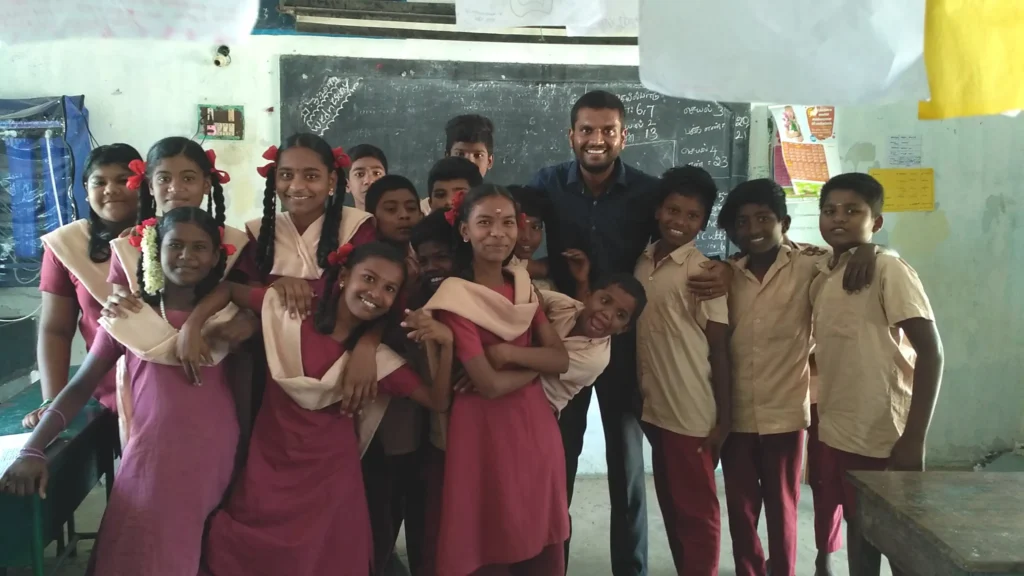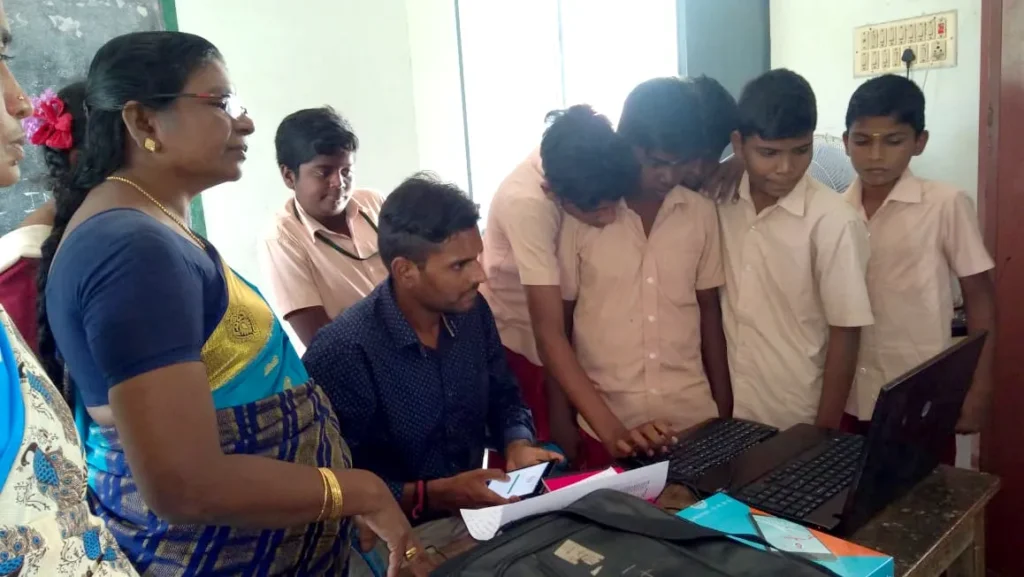From 4th January until 27th March of 2019 I conducted a pilot program in which I taught the basics of computers to ~130 students in 5 government middle schools in Thiruvallur District in Tamil Nadu. What follows is a summary of that program and the key takeaways.

If you’ve read our 2030 mandate, you’ll know that education is at the top of the list and unsurprisingly, it is also the subject of our very first initiative. While I am clear on what education should be, the approach to take in reaching that state from where we are now is not so clear. So, as a first step, I decided to conduct a pilot program to test the waters. I designed the program to incorporate some of the key qualities that I believe education should ideally possess. These qualities are:-
- Education should be available without barriers. Ideally, it should be free, but if placing an entry fee enables one to facilitate greater reach, then a modest entry fee is acceptable. But the point is that the flow of knowledge and wisdom must happen with as little friction and as few a barriers as possible.
- Education should be relevant. Students’ minds are inundated with educational content that doesn’t particularly score well in terms of personal relevance in their lives. This is an absurdity. Relevance must drive the thirst for learning!
- Education must involve learning to learn. A person is truly educated when they are able to learn what they don’t know on their own. So the primary emphasis should be on honing one’s mastery over the process of learning, rather than simply measuring the extent of one’s learning.
There’s certainly more than just these three but these were my focus during this program.
In December 2018 I approached the office of the District Educational Officer for Thiruvallur and that of the Assistant Educational Officer in Ikkadu with my interest in conducting a free computer course for students in government schools. It took a while but I received a positive response along with written permission authorizing me to teach computers to kids in 5 Panchayat Union Middle Schools in Thiruvallur for 1 hour per school per week. I drafted a basic syllabus and course outline along with my teaching schedule and shared with the Assistant Educational Officer in Ikkadu.
Before my first day on January 4th, I had to cut my long hair to look “acceptable” and “presentable” so that I didn’t create a negative impression on the kids. Quite a sacrifice that was! 🙁
What happened in the program
There’s a more detailed week-by-week report on what happened during the three months, but here is a brief contextual summary of what happened:-
- The course was completely free. In fact, I had to take leave from my work and sacrifice one day’s pay per week to make this happen. The schools were all in rural areas with kids coming predominantly from economically backward families. The schools catered to kids of classes 1 thru 8. Each of them had about a hundred or so students, but I only taught classes 6, 7 and 8, all at once, which consisted of anywhere between 12 and 30 students in all three classes combined. The schools had between 1 and 5 computers for the entire school. The kids would not have been able to afford a computer class anywhere and the localities were such that even if they were willing to pay, they would not have been able to find an instructor nearby. Even the teachers at the schools had very little experience in using computers.
- I crafted the syllabus for the course such that I was exposing the kids to the possibilities that would open up if they learned computers and to evoke a natural interest in them towards technology.
- Besides inspiring them to learn technology I also wanted to give them the basics they would need to do administrative work on computers, like emailing, browsing the internet for information, MS Word, Excel and if possible HTML.

- Unfortunately, the schools had very few machines, ranging from just one laptop for the entire school to 3, 4 or a maximum of 5 machines. And none of them had an internet connection. And not all of the students had a smartphone at home. And of those that did, only a few of them had mobile data plans. So I wasn’t able to go too far with giving them all an email ID, which was my first goal. And since I wasn’t able to get them all an email ID, I couldn’t do the subsequent steps I’d planned — to teach how to place orders on online shopping sites, how to book a train ticket online, how to register for an account on any website, etc.
- I was able to teach them how to search for information on the internet through Google, how to use basic tools on MS word, how to create tables and use formulae in MS Excel and was able to briefly touch on how to create HTML files. I made them watch some cool videos on artificial intelligence, robotics, self-driving cars among other things to show them what was possible if they learned computers and to get them excited. In fact, this is the first thing that I did.
- I had no prior experience in teaching, let alone teaching kids of this age group. So the course underwent some evolution. In the beginning, I stood in front of the entire class of 20 to 30 kids and spoke to all of them at once. I soon learned that their energy levels were so high that I couldn’t get through to any of them if I focused on all of them. So I broke down each class into 5 groups of 5–7 students and asked them to come up with a name for their group and a leader who would coordinate the group. This laid the foundation for a more effective way to ensure that I was able to reach everyone.

- After the groups were formed, I started teaching them group by group. But this this soon went for a toss because I couldn’t spend time on anything significant and get through to all groups. So I had to finally resort to directly teaching only to the leaders of the groups. The leaders of each group were in turn responsible for ensuring that the members of their groups learned the same. Also, I gave them homework for the week which the leaders had to ensure was completed by everyone in their group. The advantage to this approach was that the group leaders had the opportunity to teach others what they had learned. This was an opportunity for them to build their leadership skills.
- I set up score sheets for each school and listed the groups in it to keep track of their performance in terms of attendance and completion of homework. This was a very effective move in terms of motivating them and keeping them engaged. It worked surprisingly well. The kids were competing to get the score of their respective groups high and were keen on being the lead group in the school.
The Outcomes
So, after 3 months of investing time and energy was the program beneficial? Would it be accurate to say that the kids went away inspired and their outlooks towards technology transformed? Or at the least, would it be safe to say that they have the foundation for doing basic tasks on a computer? Was it able to enforce the qualities of education listed at the beginning of this article? Was it effective as a pilot program for the bigger agenda of building a sustainable ecosystem for real education?
The answers to these questions are not clear cut, there’s some gray area involved here. Not all the kids were at the same pace, and so not all of them made the most out of it. But at the very least, the program definitely offered them exposure to the basics of computers that they would not have had otherwise. Not only were they exposed to how to do basic things on a computer, but they also got to have hands-on practice of working on computers through the homework tasks I assigned them. They also had a look at videos of latest cutting edge technologies that they wouldn’t have been exposed to otherwise. A handful of kids, say about 5–8 in all the 5 schools combined, were at the top of the game and put in more than the other kids did. These kids learned how to do all of the tasks that I taught them and some of them even got to practice creating HTML web pages.
Was it able to enforce the qualities of education I designed this program upon? Well, it was free, but other than that, the duration of the program was too short to ensure other things such as helping them understand the relevance of what they were learning. Also, my plans of making them learn to learn took a hit because of the lack of internet connection at home or school, because my intention was to help them learn how to research for information on the internet and then do some assignments based on that.
Was this effective in its primary agenda of being a pilot program for revolutionising education? I would say that while the program on its own didn’t deliver much to show off, it has given me some solid leads for where to take it from here. It has exposed me to the real world challenges of working with children and with the schools given how they work. It has also given me ideas of some pedagogical approaches to use in making learning engaging. I’m definitely more comfortable about making more expansive attempts, and also clearer on which direction to take it. Most importantly, I have some ideas about what to do next.

Leave a Reply